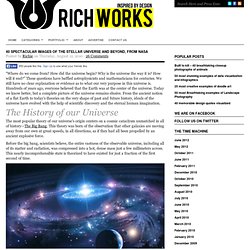

How Many People Are In Space Right Now? Photo Tour of The Solar System. If possible, the first images in each set will be true-color, as you would see them with your own eyes.

Most images will either be true-color or monochrome (black and white), unless stated otherwise. Many images can be vastly enlarged by clicking on them and choosing a larger size from the Flickr page. Downloading them may allow even larger sizes. It appears there's a limit to the size of diaries, so this first part of the tour ends about 3/4 of the way through the Saturn system (which is quite extensive). I. You might be tempted to think Mercury is very similar to the Moon, but compare and contrast them, and think about what the differences might mean.
II. Through UV and orange filters: From the Soviet Venera 13 lander: From Venera 14: This is a perspective mosaic of Venera images put together by Don P. III. 40 Spectacular images of the Stellar Universe and beyond, from NASA. 40 Spectacular images of the Stellar Universe and beyond, from NASA Posted by Richie on Thursday, August 12, 2010 · 26 Comments “Where do we come from?

How did the universe begin? Why is the universe the way it is? How will it end?” The History of our Universe The most popular theory of our universe’s origin centers on a cosmic cataclysm unmatched in all of history—The Big Bang. Before the big bang, scientists believe, the entire vastness of the observable universe, including all of its matter and radiation, was compressed into a hot, dense mass just a few millimeters across. Big bang proponents suggest that some 10 billion to 20 billion years ago, a massive blast allowed all the universe’s known matter and energy—even space and time themselves—to spring from some ancient and unknown type of energy.
Scientists can’t be sure exactly how the universe evolved after the big bang. The big bang theory leaves several major questions unanswered. The Hubble Space Telescope: The Elegant Universe: Pt 1. The Elegant Universe: Part 3 PBS Airdate: November 4, 2003 NARRATOR: Now, on NOVA, take a thrill ride into a world stranger than science fiction, where you play the game by breaking some rules, where a new view of the universe pushes you beyond the limits of your wildest imagination.
This is the world of "string theory," a way of describing every force and all matter from an atom to earth, to the end of the galaxies—from the birth of time to its final tick, in a single theory, a "Theory of Everything. " Our guide to this brave new world is Brian Greene, the bestselling author and physicist. BRIAN GREENE (Columbia University): And no matter how many times I come here, I never seem to get used to it. NARRATOR: Can he help us solve the greatest puzzle of modern physics—that our understanding of the universe is based on two sets of laws that don't agree? NARRATOR: Resolving that contradiction eluded even Einstein, who made it his final quest. S.